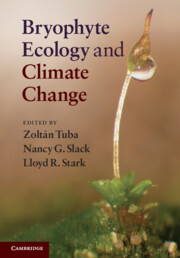Book contents
- Frontmatter
- Contents
- List of contributors
- Preface
- I Introductory Chapters
- II Ecophysiology
- III Aquatic Bryophytes
- IV Desert and Tropical Ecosystems
- V Alpine, Arctic, and Antarctic Ecosystems
- VI Sphagnum and Peatlands
- VII Changes in Bryophyte Distribution with Climate Change: Data and Models
- 17 The Role of Bryophyte Paleoecology in Quaternary Climate Reconstructions
- 18 Signs of Climate Change in the Bryoflora of Hungary
- 19 Can the Effects of Climate Change on British Bryophytes be Distinguished from those Resulting from Other Environmental Changes?
- 20 Climate Change and Protected Areas: How well do British Rare Bryophytes Fare?
- 21 Modeling the Distribution of Sematophyllum substrumulosum (Hampe) E. Britton as a Signal of Climatic Changes in Europe
- 22 Modeling Bryophyte Productivity Across Gradients of Water Availability Using Canopy Form–Function Relationships
- VIII Conclusions
- Index
- References
22 - Modeling Bryophyte Productivity Across Gradients of Water Availability Using Canopy Form–Function Relationships
Published online by Cambridge University Press: 05 October 2012
- Frontmatter
- Contents
- List of contributors
- Preface
- I Introductory Chapters
- II Ecophysiology
- III Aquatic Bryophytes
- IV Desert and Tropical Ecosystems
- V Alpine, Arctic, and Antarctic Ecosystems
- VI Sphagnum and Peatlands
- VII Changes in Bryophyte Distribution with Climate Change: Data and Models
- 17 The Role of Bryophyte Paleoecology in Quaternary Climate Reconstructions
- 18 Signs of Climate Change in the Bryoflora of Hungary
- 19 Can the Effects of Climate Change on British Bryophytes be Distinguished from those Resulting from Other Environmental Changes?
- 20 Climate Change and Protected Areas: How well do British Rare Bryophytes Fare?
- 21 Modeling the Distribution of Sematophyllum substrumulosum (Hampe) E. Britton as a Signal of Climatic Changes in Europe
- 22 Modeling Bryophyte Productivity Across Gradients of Water Availability Using Canopy Form–Function Relationships
- VIII Conclusions
- Index
- References
Summary
Introduction
Bryophytes can dominate plant–atmosphere exchange surfaces in mesic to hydric Arctic, boreal, and temperate ecosystems and can contribute up to 50% of gross primary production (Goulden & Crill 1997; Bisbee et al. 2001; O'Connell et al. 2003a), although estimates in more dense forests are lower (Skre & Oechel 1979; Kolari et al. 2006). Soils in these systems store approximately one third of the world's reactive pool of soil carbon (McGuire et al. 1995) with a major contribution coming from bryophytes (Gorham 1991; O'Neill 2000; Turetsky 2003). Within these systems, the bryophyte layer also influences hydrology, nutrient uptake and cycling, and soil temperature.
In the boreal zone, significant research has been undertaken to determine how forest bryophytes affect carbon exchange and sequestration. These studies have focused on the influence of environmental forcing variables (e.g., temperature, light, and water availability) on the productivity and carbon dynamics of feathermoss (Pleurozium) and Sphagnum moss species, the two most dominant groups ecologically. This work has led to a better understanding of temporal variation in bryophyte function and has provided insights into how the performance of individual species varies across gradients of temperature, light intensity, and water availability (Skre & Oechel 1979; Trumbore & Harden 1997; Bisbee et al. 2001; O'Connell et al. 2003a, b; Heijmans et al. 2004; Kolari et al. 2006; Kulmala et al. 2008).
However, these studies have neglected the causes and consequences of intraspecific variation, which can be similar in magnitude to differences among species.
Information
- Type
- Chapter
- Information
- Bryophyte Ecology and Climate Change , pp. 441 - 458Publisher: Cambridge University PressPrint publication year: 2011
References
Accessibility standard: Unknown
Why this information is here
This section outlines the accessibility features of this content - including support for screen readers, full keyboard navigation and high-contrast display options. This may not be relevant for you.Accessibility Information
- 8
- Cited by
